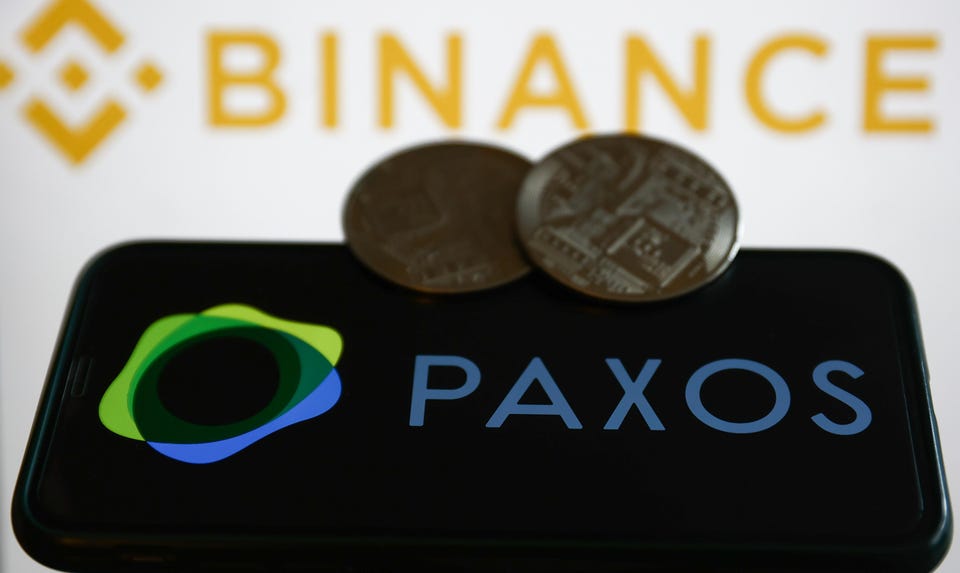Stablecoin Issuers May Be Crypto Industry’s Achilles’ Heel


Paxos logo displayed on a phone screen, representation of cryptocurrencies and Binance logo … [+] displayed on a screen in the background are seen in this illustration photo taken in Krakow, Poland on February 13, 2023. (Photo by Jakub Porzycki/NurPhoto via Getty Images)
NurPhoto via Getty Images
When New York regulators ordered the crypto exchange Paxos to stop minting stablecoins this week, it revealed one of the Ethereum ETH ecosystem’s greatest weaknesses: Fiat-backed stablecoin issuers that must obey laws in their respective jurisdictions.
The combined market capitalization of the three major stablecoins (USDT USDT , USDC USDC , BUSD BUSD respectively) is equal to ~46% of Ethereum’s total market capitalization today of ~$180 billion, according to CoinMarketCap.com. These three stablecoins are fiat-backed, meaning each stablecoin is supposedly backed 1:1 by cash, short-dated U.S. treasuries, and, in the case of USDT, non-US treasury bonds, precious metals, loans, and investments. By contrast, the Ethereum ecosystem’s preeminent DeFi project, Uniswap, has a market cap of $5 billion.

Market cap of USDT, USDC and BUSD as a percentage of Ethereum’s total market cap
Data source: https://www.theblock.co/data/decentralized-finance/stablecoins
The raison d’etre of many cryptocurrency firms is to decentralize finance by reducing dependency on institutional powers and increasing self-custody options and peer-to-peer transaction access. Consequently they have often had difficulties gaining access to the traditional banking system. Stablecoins offered a solution to this challenge, allowing users and crypto exchanges alike to reduce their reliance on slow bank transfers by representing dollars on-chain. But the major stablecoins have idiosyncratic risks, due to their dependence on centralized financial institutions, which is increasingly apparent when regulators restrict stablecoin issuers themselves.
Such was the case this week with Paxos Trust Co, the issuer of BUSD through a partnership with the fellow crypto exchange Binace. Paxos was told by the New York Department of Financial Services (NYDFS) to stop issuing that stablecoin, effective February 21st. The Securities and Exchange Commision (SEC) also sent Paxos a stern warning this week, alleging that BUSD is a security and may attract further enforcement action. Binance’s CEO, Changpeng Zhao, tweeted on Monday: “BUSD is a stablecoin wholly owned and managed by Paxos. As a result, BUSD market cap will only decrease over time. Paxos will continue to service the product, and manage redemptions.”
According to Nansen data analytics, about 90% of BUSD is still held on Binance, the world’s largest crypto currency exchange. The exchange has played a key role in increasing adoption of cryptocurrencies in emerging markets by offering convenient interfaces for users to convert local currencies to BUSD and other cryptocurrencies. According to a 2022 survey by MasterCard, a third of respondents from Latin America claimed they had used stablecoins for everyday purchases. Stablecoins like BUSD opened up new opportunities for people disconnected from the global economy. Will current users of BUSD migrate to other fiat-backed stablecoins, experiment with crypto-backed options, or stop relying on stablecoins altogether?
Regulating fiat-backed stablecoins out of the market would temporarily make it more difficult for individuals and businesses across the world to access the cryptocurrency ecosystem. But it would not stop innovation and experimentation with crypto-backed stablecoin alternatives like DAI DAI . Nor would stablecoin regulation stop the increasing adoption of cryptocurrencies like bitcoin. The MakerDAO Foundation behind DAI may expect regulators to scrutinize nonprofits and other types of stablecoin issuers as well, not just crypto exchanges. The MakerDAO community recently launched a $5 million legal defense fund.
For now, the US dollar and banking system remain king and queen of the internet economy. But, unless regulators provide clarity and work together with the crypto industry, US regulators may soon lose their advantage in the international markets. If so, US banks may find themselves crushed by the wheels of history.
